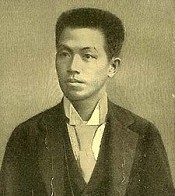Aguinaldo Emilio

Emilio Aguinaldo y Famy[3][4] (March 22, 1869 – February 6, 1964) was a Chinese Filipino general, politician, and independence leader. He played an instrumental role in Philippine independence during the Philippine Revolution against Spain and the Philippine-American War that resisted American occupation. He eventually pledged his allegiance to the US government. In the Philippines, Aguinaldo is considered to be the country's first and the youngest Philippine President. The seventh of eight children of Crispulo Aguinaldo and Trinidad Famy, he was born into a Filipino family on March 22, 1869 in Cavite El Viejo (now Kawit), Cavite province. His father was gobernadorcillo (town head), and, as members of the Chinese Tagalog mestizo minority, they enjoyed relative wealth and power. As a young boy he received education from his great-aunt and later attended the town's elementary school. In 1880, he took up his secondary course education at the Colegio de San Juan de Letran, which he quit on his third year to return home instead to help his widowed mother manage their farm. At the age of 28, Emilio was elected cabeza de barangay of Binakayan, the most progressive barrio of Cavite El Viejo. He held this position serving for his town-mates for eight years. He also engaged in inter-island shipping, travelling as far south as the Sulu Archipelago. In 1893, the Maura Law was passed to reorganize town governments with the aim of making them more effective and autonomous, changing the designation of town head from gobernadorcillo to capitan municipal effective 1895. On January 1, 1895, Aguinaldo was elected town head, becoming the first person to hold the title of capitan municipal of Cavite El Viejo. His first marriage was in 1896 with Hilaria Del Rosario (1877-1921). They had five children (Miguel, Carmen, Emilio Jr., Maria and Cristina). His second wife was Maria Agoncillo (1882-1963). Several of Aguinaldo's descendants became prominent political figures in their own right. A grandnephew, Cesar Virata, served as Prime Minister of the Philippines from 1981 to 1986. Aguinaldo's granddaughter, Ameurfina Herrera, served as an Associate Justice of the Supreme Court from 1979 until 1992 In 1895, Aguinaldo joined the Katipunan, a secret organization led by Andrés Bonifacio, dedicated to the expulsion of the Spanish and independence of the Philippines through armed force. Aguinaldo used the nom de guerre Magdalo, in honor of Mary Magdalene. His local chapter of the Katipunan, headed by his cousin Baldomero Aguinaldo, was also called Magdalo.[5] The Katipunan revolted against the Spanish colonizers in the last week of August 1896, starting in Manila. However, Aguinaldo and other Cavite rebels initially refused to join in the offensive due to lack of arms. Their absence contributed to Bonifacio's defeat in San Juan del Monte.[5] While Bonifacio and other rebels were forced to resort to guerrilla warfare, Aguinaldo and the Cavite rebels won major victories in set-piece battles, temporarily driving the Spanish out of their area.[5] Conflict between the Magdalo and another Cavite Katipunan faction, the Magdiwang, led to Bonifacio's intervention in the province. The Cavite rebels then made overtures about establishing a revolutionary government in place of the Katipunan. Though Bonifacio already considered the Katipunan to be a government, he acquiesced and presided over elections held during the Tejeros Convention in Tejeros, Cavite on March 22, 1897. Away from his power base, Bonifacio lost the leadership to Aguinaldo, and was elected instead to the office of Secretary of the Interior. Even this was questioned by an Aguinaldo supporter, claiming Bonifacio had not the necessary schooling for the job. Insulted, Bonifacio declared the Convention null and void, and sought to return to his power base in Morong (present-day Rizal). He and his party were intercepted by Aguinaldo's men and violence resulted which left Bonifacio seriously wounded. Bonifacio was charged, tried and found guilty of treason by a Cavite military tribunal, and sentenced to death. After some vacillation, Aguinaldo confirmed the death sentence, and Bonifacio was executed on May 10, 1897 in the mountains of Maragondon in Cavite, even as Aguinaldo and his forces were retreating in the face of Spanish assault.[5] Spanish pressure intensified, eventually forcing Aguinaldo's forces to retreat to the mountains. Gen. Emilio Aguinaldo signed the treaty of Biak-na-Bato, which specified that the Spanish would give self-rule to the Philippines within 3 years if Gen. Emilio Aguinaldo was exiled. On December 14, 1897, Aguinaldo was shipped to Hong Kong. Under the pact, Aguinaldo agreed to end hostilities as well in exchange for amnesty and "$800,000 (Mexican)" (Aguinaldo's description of the amount)[6][7] as an indemnity. Aguinaldo took the money offered. Emilio Aguinaldo was President and Mariano Trias (Vice President). Other officials included Antonio Montenegro for Foreign Affairs, Isabelo Artacho for the Interior, Baldomero Aguinaldo for the Treasury, and Emiliano Riego de Dios for War. However, thousands of other Katipuneros continued to fight the Revolution against Spain for a sovereign nation. Unlike Aguinaldo who came from a privileged background, the bulk of these fighters were peasants and workers who were not willing to settle for 'indemnities.' In early 1898, war broke out between Spain and the United States. Aguinaldo returned to the Philippines in May 1898. He immediately resumed revolutionary activities against the Spaniards, now receiving verbal encouragement from emissaries of the U. S. On the night of February 4, 1899, a Filipino was shot by an American sentry. This incident is considered the beginning of the Philippine-American War, and open fighting soon broke out between American troops and pro-independence Filipinos. Superior American firepower drove Filipino troops away from the city, and the Malolos government had to move from one place to another. Aguinaldo led resistance to the Americans, then retreated to northern Luzon with the Americans on his trail. On June 2, 1899, a telegram from Aguinaldo was received by Gen. Antonio Luna, an arrogant but brilliant general and looming rival in the military hierarchy, ordering him to proceed to Cabanatuan, Nueva Ecija for a meeting at the Cabanatuan Church Convent. However, treachery was afoot, as Aguinaldo felt the need to rid himself of this new threat to power. Three days later (June 5), when Luna arrived, he learned Aguinaldo was not at the appointed place. As Gen. Luna was about to depart, he was shot, then stabbed to death by Aguinaldo's men. Luna was later buried in the churchyard, and Aguinaldo made no attempt to punish or even discipline Luna's murderers. Less than two years later, after the famous Battle of Tirad Pass with the death of Gregorio del Pilar, one of his most trusted generals, Aguinaldo was captured in Palanan, Isabela on March 23, 1901 by US General Frederick Funston, with the help of Macabebe trackers (who saw Aguinaldo as a bigger problem than the Americans). The American task force gained access to Aguinaldo's camp by pretending to be captured prisoners. Funston later noted Aguinaldo's "dignified bearing", "excellent qualities," and "humane instincts." Of course, Funston was writing this after Aguinaldo had volunteered to swear fealty to the United States, if only his life was spared. Aguinaldo pledged allegiance to America on April 1, 1901, formally ending the First Republic and recognizing the sovereignty of the United States over the Philippines. Nevertheless, many others (like Miguel Malvar and Macario Sakay) continued to resist the American occupation. The insurgent First Philippine Republic was formally established with the proclamation of the Malolos Constitution on January 21, 1899 in Malolos, Bulacan and endured until the capture and surrender of Emilio Aguinaldo to the American forces on March 23, 1901 in Palanan, Isabela, which effectively dissolved the First Republic. Aguinaldo appointed two premiers in his tenure. These were Apolinario Mabini and Pedro Paterno. The Malolos Congress continued its sessions and accomplised certain positive tasks. The Spanish fiscal system was provisionally retained. The same was done with the esisting taxes, save those upon cockfighting and other amusements. War taxes were levied and voluntary contributions were solicited. Customs duties were established. A national loan was launched. President Aguinaldo ordered schools opne. Elementary education was made compulsary and free. The Filipino educator, Erique Mendiola, founded the "Instituto de Burgos" and were appointed by the Director of Public Instruction. It offered courses in agriculture, surveying, and commerce, as well as a complete A.B course. On October 1898 a government decree created the "Universidad Literia". Couses offered were Medicine, Surgery, Pharmacy, and Notary Public. The President of the Philippines appointed the professors thereof. They, in turn, chose the University rector. The first to occupy this position was Joaquin Gonzales. Later, he was succeded by Dr. leo Ma. Guerrero.[8] President Aguinaldo had two cabinets in the year 1899. Thereafter, the war situation resulted in his ruling by decree. The Philippine–American War was an armed military conflict between the Philippines and the United States, which arose from the struggle of the First Philippine Republic against United States annexation of the islands.[9][10] The war was a continuation of the Philippine struggle for independence, following the Philippine Revolution, led by Emilio Aguinaldo and the Spanish-American War. The struggle officially began on June 2, 1899, when the Philippines declared war against the United States and it officially ended on July 4, 1902, after Aguinaldo's surrender.[11][12] However, remnants of the Katipunan and other resistance groups, such as the Muslims and Pulajanes continued hostilities until June 15, 1913 (Battle of Bud Bagsak).[12][13] The war led to the establishment of the Anti-Imperialist League by Mark Twain, who staunchly opposed the war, as well as to writing of The White Man's Burden by Rudyard Kipling which is a poem about colonialism. In its aftermath, the war would change the cultural landscape of the islands with the introduction of the English language, the disestablishment of the Catholic Church, and the impact of an estimated 200,000-1,500,000 casualties.
do you like this author?
What readers are saying
What do you think? Write your own comment on this book!
write a commentWhat readers are saying
What do you think? Write your own comment on this author!
write a commentBook list

True Version of the Philippine Revolution
Series:
Unknown
Year:
Unknown
Raiting:
2.5/5
Account of the Philippine Revolution against Spain, and the Philippine-American War from the Filipino general and independence leader. --This text refers to an alternate Paperback edition.
Show more
add to favoritesadd In favorites
Book list

True Version of the Philippine Revolution
Series:
Unknown
Year:
Unknown
Raiting:
2.5/5
Account of the Philippine Revolution against Spain, and the Philippine-American War from the Filipino general and independence leader. --This text refers to an alternate Paperback edition.
Show more
add to favoritesadd In favorites
What readers are saying
What do you think? Write your own comment on this author!
write a commentif you like Aguinaldo Emilio try:
readers also enjoyed
What readers are saying
What do you think? Write your own comment on this author!
write a commentif you like Aguinaldo Emilio try:
readers also enjoyed
Do you want to read a book that interests you? It’s EASY!
Create an account and send a request for reading to other users on the Webpage of the book!


